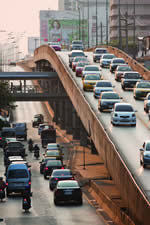
Does the thought of merging onto the freeway cause you to break into a cold sweat? When you gun your car, hurtling down the entrance ramp, do you pray fast and furious to Everything Holy, begging for a gap that lets you ease into the flow alive and unscathed? All those prayers notwithstanding, do you remain convinced that Death and Destruction eagerly await you, smiling, rubbing their hands together at the end of the ramp?
Fear not, intrepid Road Warrior. Christian Poellabauer, Notre Dame associate professor of computer science and engineering, and his colleagues at ND’s Wireless Institute are working on a research project aimed at eliminating some of life’s most frightening moments behind the wheel.
Poellabauer’s group is collaborating with Toyota engineer John Kenney ’88Ph.D. on methods to improve the reliability of “dedicated short-range communications” (DSRC), a technology that allows cars to “talk” to one another.
For instance, a DSRC safe auto app might warn a driver of an impending collision, or it could gauge traffic flow and help with freeway merging. The app also could alert a driver that a vehicle is in the car’s blind spot, or tell when it’s okay to change lanes.
Safety-related information could be displayed not only on a car’s dashboard but also on the driver’s cell phone. Additionally, Poellabauer says smart phone sensors might be used by the system to gather additional safety-enhancing information.
Today’s cell phones, the associate director of ND’s Wireless Institute explains, offer engineers a bundle of sensors, including everything from global positioning systems and accelerometers — which are handy for auto safety applications — to light sensors, barometric pressure gauges and who-knows-what by the time you read this. Plus all of these gauges and sensors can “talk” to one another. That linking capability, Poellabauer says, offers amazing possibilities.
If, for instance, all the smart phone barometric pressure gauges were linked, it might make for super accurate local weather prediction. With all these data collection points we might create some interesting and useful things, Poellabauer says. Imagination is the only limit.
John Monczunski is an associate editor of Notre Dame Magazine.